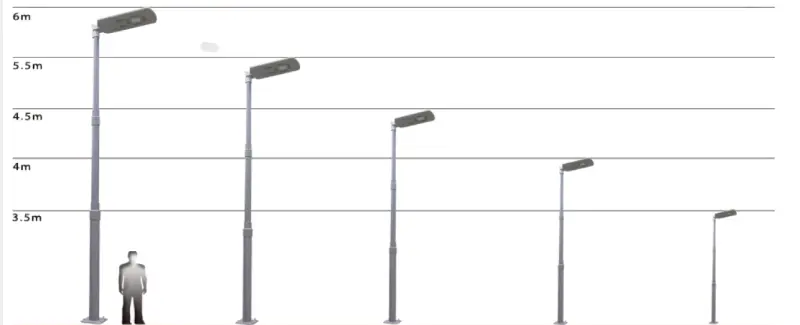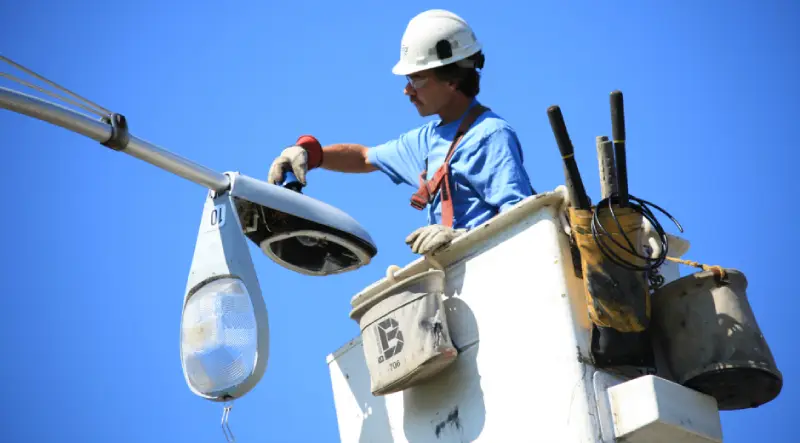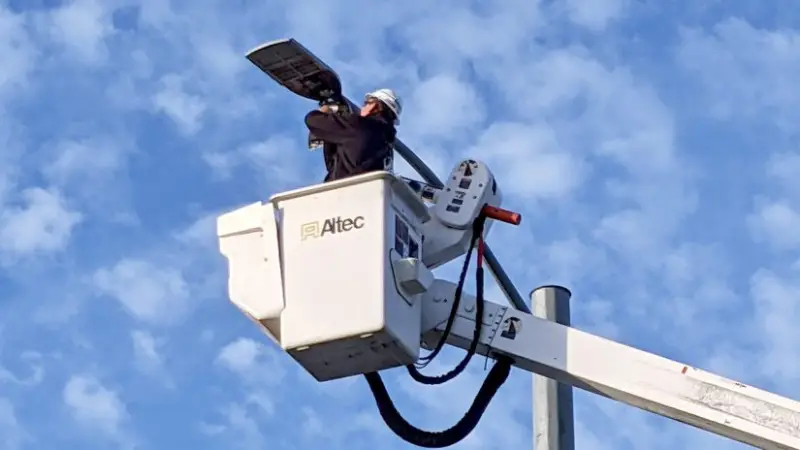Height and Spacing Calculator of Street Light
Specification for The Installation Spacing of Street Light
The installation spacing of street lamps needs to be reasonably set according to the type and width of the road. Generally speaking, the spacing of street lights installed on urban roads should be determined based on the type of road and the width of the roadway. The specific specifications are as follows:
- Urban main roads: When the width of the roadway is ≤ 10m, the distance between street lamps is 25m; Roadway width>; At 10m, the distance between street lamps is 30m.
- Urban secondary roads: When the width of the roadway is ≤ 8m, the distance between street lamps is 25m; Roadway width>; At 8m, the distance between street lamps is 30m.
- General urban roads: When the width of the roadway is ≤ 6m, the distance between street lamps is 20m; Roadway width>; At 6m, the distance between street lamps is 25m.
- Secondary roads in urban areas: When the width of the roadway is ≤ 6m, the distance between street lamps is 20m; Roadway width>; At 6m, the distance between street lamps is 25m.
- Rural roads: The distance between street lamps is generally 30-50m.
What You Should Know About Height and Spacing of Street Lights
What Is the Typical Height of a Street Light

The height of street lamps is generally between 4-12 meters, depending on factors such as road width, road grade, and sidewalk width.
Common Standards for the Height of Street Light
Street lamps are the main facilities for urban road lighting, and the reasonable selection of their height plays a crucial role in the lighting effect and aesthetics of the city. Generally speaking, the height of streetlights on urban roads ranges from 4 to 12 meters, with common standard heights including 6 meters, 8 meters, 10 meters, etc.
Height Selection of Street Lights in Different Scenarios
- Road grade
On highways, high pole street lights of more than 10 meters are generally used to enhance the lighting range and ensure the safety of the road surface. On ordinary roads, the height of streetlights generally does not exceed 8 meters. In residential areas, parking lots, and other scenarios, the height of street lights is generally lower to provide appropriate lighting without affecting residents’ rest.
- Road section width
The width of the road section is also an important consideration for the height of street lamps. On narrow road sections, the height of street lamps can be appropriately reduced to avoid excessive spacing between them affecting the lighting range.
- Width of pedestrian walkway
On wide sidewalks, in order to ensure pedestrian safety and visibility, the height of streetlights should be appropriately increased. On narrow sidewalks, the height of streetlights can be appropriately reduced to achieve a reasonable lighting range.
In summary, the height selection of street lamps needs to be reasonably chosen according to the scene and actual situation. When installing street lights, it is necessary to strictly follow relevant standards to ensure lighting effectiveness and safety.
What is the Distance Between Street Lights?

As is well known, the installation process of street lights is simple and easy, and the required accessories only need to be assembled simply. However, we need to pay attention to some key points during the installation process, especially the spacing issue of street lamp installation.
In theory, the spacing between street lights is the same as that of ordinary street lights, which is 3-5 times the height of the lamp post. For example, if a 6-meter lamp post is used, the installation spacing should be around 25-30 meters, and if an 8-meter lamp post is used, the installation spacing should be around 30-35 meters. This spacing setting can ensure that the street lamps do not obstruct each other while illuminating the road, improving the lighting effect.
However, as most street lights are installed in rural areas, the presence of obstructions such as trees needs to be considered. These obstructions may affect the lighting effect of street lamps, so it is necessary to adjust the installation location and spacing appropriately. In rural environments, when installing solar street lights, it is necessary to fully consider factors such as terrain, buildings, and trees to achieve the best lighting effect and energy utilization efficiency.
In addition to spacing issues, the installation of street lights also needs to pay attention to the following points: first, choose a suitable installation location to avoid sunlight being blocked or affected by other factors; Secondly, it is necessary to ensure that the solar panels face sunlight to ensure sufficient energy supply; Finally, during the installation process, it is necessary to ensure the stability and safety of the lamp post and solar panel to prevent accidents from occurring.
In short, although the installation process of street lights is relatively simple, there are many issues that need to be noted in practical operation. Only by fully considering various factors can we ensure the normal operation of solar street lights and achieve the best lighting effect.
What Should Be Paid Attention to When Installing Street Lights?

- Lamp height
When installing street lamps, attention should be paid to the height. The higher the height, the wider the illumination field of the street lamp. Generally, the height of streetlights on the same street is consistent. For small curved lights, the installation height is 5-6 meters. For long arm lights, the installation height is 6-7 meters. For curved lights, the installation height is about 8 meters. In addition, the installation height of special lamp types needs to be determined by the width of the road.
- Lamp elevation angle
Secondly, when installing street lamps, attention should be paid to the elevation angle of the lamps, which is determined by the road width and light distribution curve. If the light can be adjusted, the center of the light source can be placed within the centerline of the road width. If it is a long arm lamp, the lamp head should be raised 100 millimeters above the pole. The elevation angle of special lighting fixtures is determined by the light distribution curve.
- Street light fixtures
When installing street lamps, it is important to ensure that the lighting fixtures are firm and upright, and not loose or skewed. And the lampshade should be intact and undamaged. When encountering problems such as corrosion of enamel lamp umbrellas and failure of reflective mirrors, they need to be replaced in a timely manner. In addition, the lamp body should not be bent, and all screws should be tightened.
Summary: The above is the relevant content about the general height of street lamps and what to pay attention to when installing street lamps. We hope it can be helpful for friends in need. If you need to learn more about related knowledge in the future, please follow Qijia.com for information.
How to Do a Good Job in Maintaining LED Street Lights?

- Regular inspection: Regularly inspect the LED street lamp body, power cord, controller and other components for looseness, damage, etc., to ensure that the brightness of the lamp is normal and the color of the light source is uniform. At the same time, pay attention to the heat dissipation of the lighting fixtures and the impact of the surrounding environment to ensure that the lighting fixtures are in good working condition.
- Cleaning and dust removal: The surface of the lamp will accumulate dust and dirt, causing scattering and absorption of light. Therefore, regular cleaning and dust removal can restore the lighting effect of the light source and improve the brightness of the street lamp. During the cleaning process, a soft cloth or sponge should be used to avoid using hard objects or chemical solvents to prevent damage to the lampshade and lamp body.
- Replacement of LED bulbs: The brightness and lifespan of LED street lights are closely related to the bulbs. If any abnormalities are found in the LED beads, high-quality LED beads should be replaced in a timely manner to ensure the normal operation of the lighting fixtures.
- Power maintenance: The power supply is a critical component for the normal operation of LED street lights. Regularly check whether the power cord and connector are stable to ensure the normal working condition of the power supply and power cord. At the same time, conduct voltage and current tests to ensure that they are within a reasonable range. If conditions permit, it is possible to consider using devices such as voltage regulators to provide a more stable power supply.
- Waterproof and anti-theft measures: Many LED street lights are equipped with batteries, which need to be checked regularly for water leakage or theft. The charging and discharging status of the battery should also be checked to ensure that it is in normal condition. In addition, attention should be paid to waterproof measures to ensure that components such as LED street lamp heads and batteries do not get wet.



